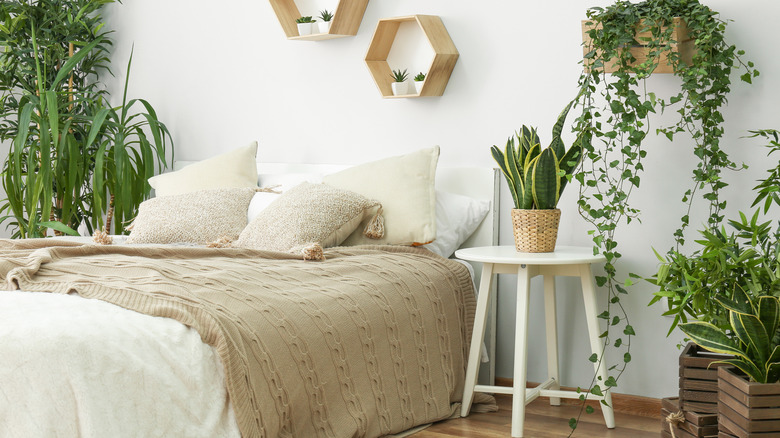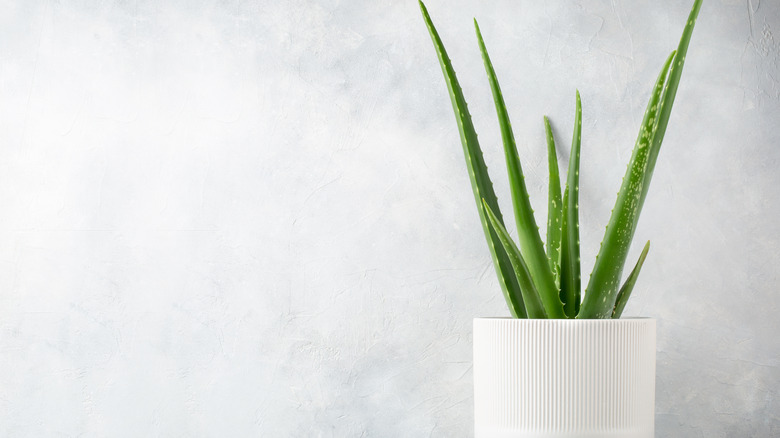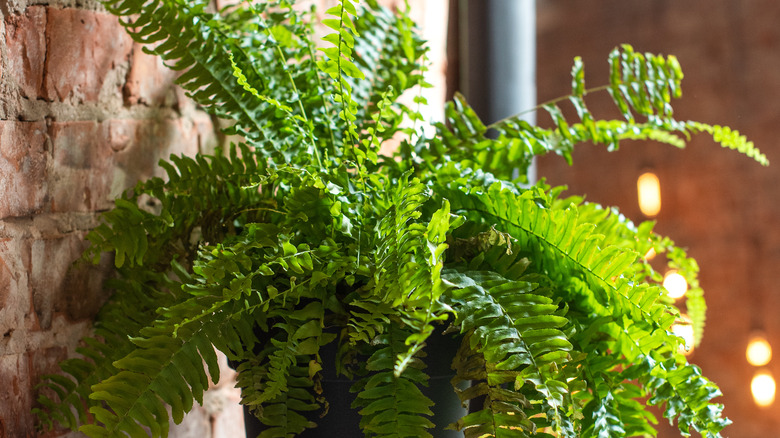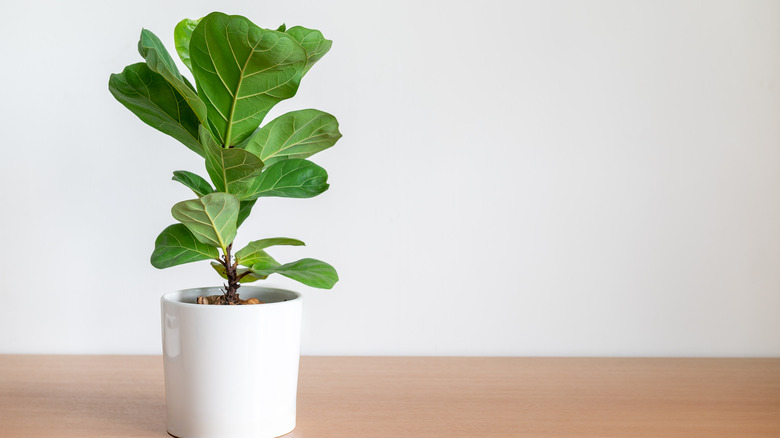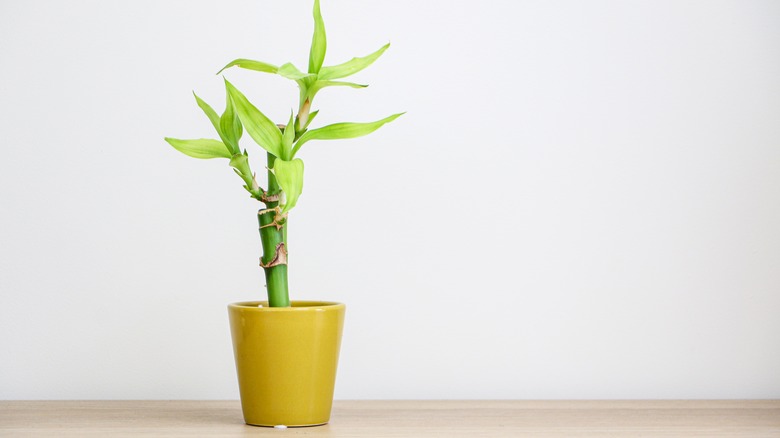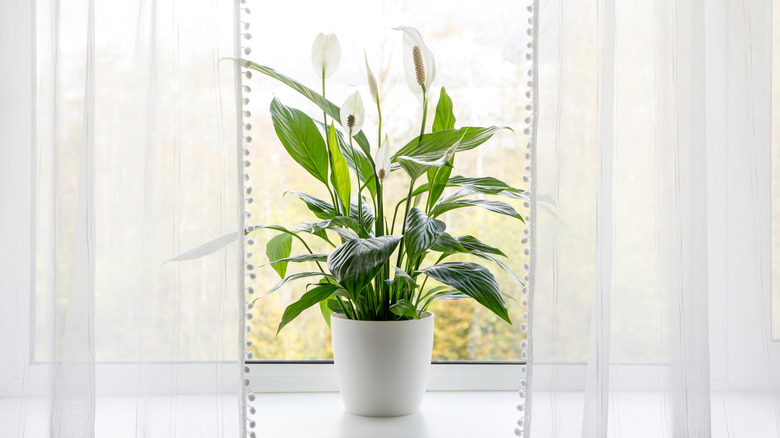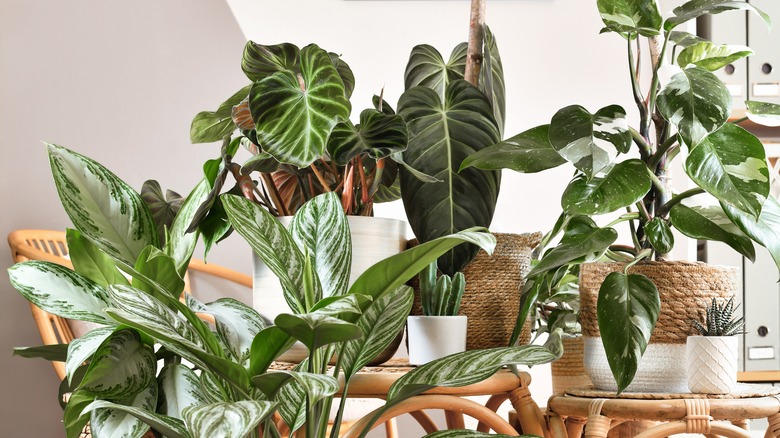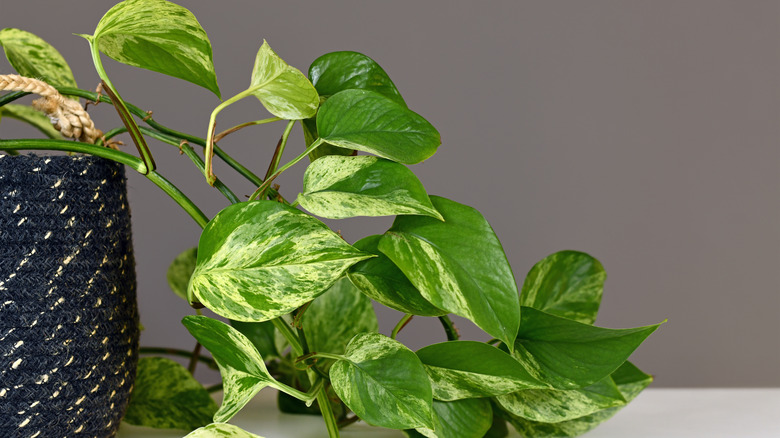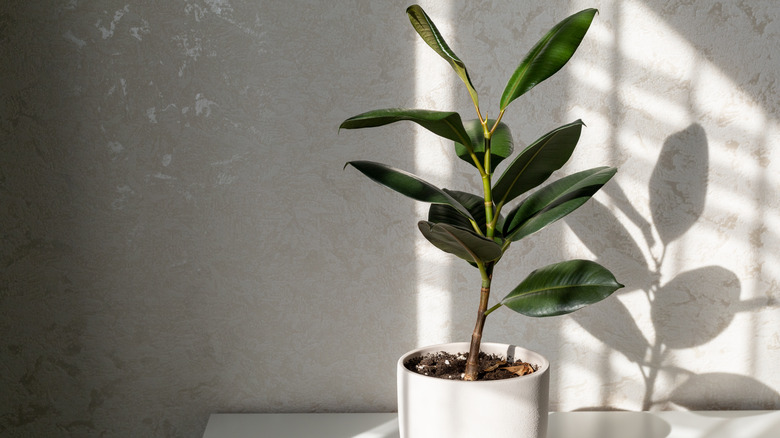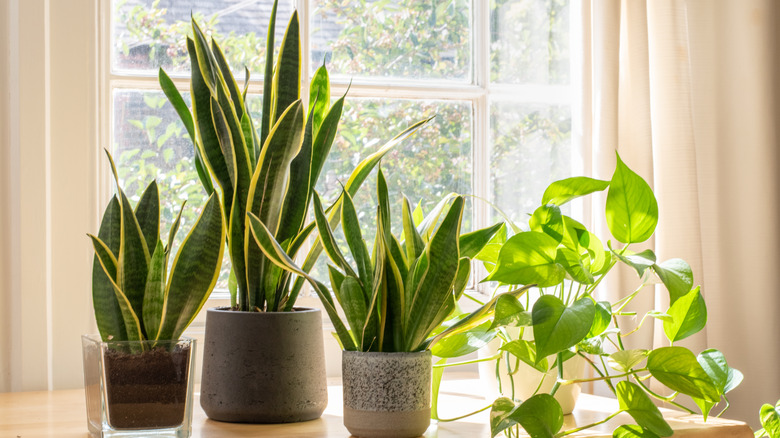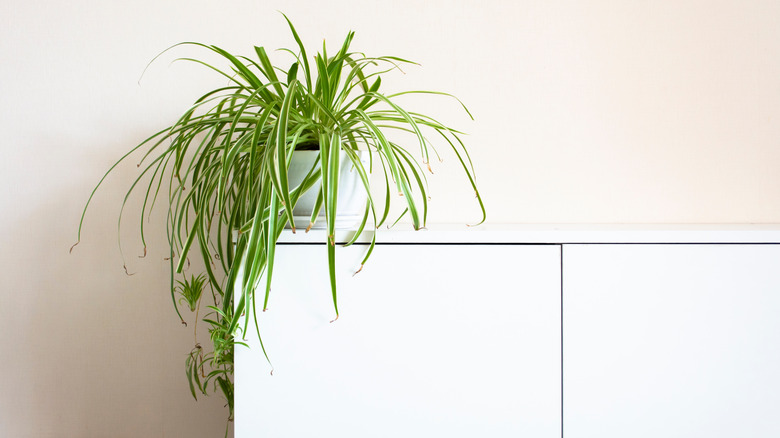10 Houseplants To Make Your Bedroom Cozier And More Inviting
For centuries, people have decorated their homes with houseplants. Their lovely stems, leaves, and flowers lend a vibrant and graceful ambiance to an indoor living space. Additionally, indoor gardeners enjoy tending to houseplants and watching them grow. Houseplants placed in a bedroom may contribute to a calm and relaxing atmosphere. In a study reported by the Journal of Physiological Anthropology, participants who interacted with plants experienced decreased feelings of stress. A reduction in diastolic blood pressure accompanied their feelings of "comfort." Therefore, it's reasonable to add a few houseplants to your bedroom as you try to create a restful sanctuary for healthy sleep.
Don't be frightened by the myth that plants are unsafe in the bedroom due to their release of carbon dioxide at night. The truth is that a houseplant emits a minuscule amount of carbon dioxide compared to a human (via BBC Science Focus). Therefore, the natural cycles of photosynthesis and respiration for plants do not pose a threat to the occupants of your bedroom.
Aloe vera
Aloe vera is a succulent plant that is easy to care for. It features a very short stem with fleshy leaves that spike upward from the center. Farmers' Almanac advises that you plant the aloe vera in a terra cotta pot or another container that breathes, ensuring water can evaporate quickly and not cause root rot. You also want to ensure there is at least one drainage hole in the bottom. Then, water the plant thoroughly but sparingly. Since it's a succulent, it doesn't need a lot of water to survive. You can water it every three weeks during the summer (when it's the most active,) allowing the first few inches of topsoil to dry out before watering it again. In the bedroom, your aloe vera will thrive in bright but indirect sunlight. It will grow in artificial light, as well.
The aloe vera plant is not only a lovely addition to your bedroom decor, but the gel from the plant is an effective topical treatment for skin irritations. According to the National Institutes of Health, aloe vera gel produces desirable results when applied to the skin to treat acne, certain skin rashes, and burns. It not only contributes to healing the affected area but may also reduce the sensation of pain resulting from a burn.
Boston fern
The Boston fern lends a gentle, old-fashioned vibe to your bedroom. House Plants Expert explains that each frond of a Boston fern consists of a stalk with myriad, delicate leaves compacted closely together and growing down its length. With the graceful fronds cascading over the side of a container, the Boston fern looks beautiful in either a hanging basket or a tabletop vessel. Start a Boston fern in a pot, then transplant it to a hanging basket when the fronds measure more than 1 foot long. The dense, feathery fronds of the plant will create an impressive display in front of a bedroom window.
According to Mod and Mint Plant Care, Boston ferns thrive in humid conditions. You should water them frequently and never let the soil dry out. On the other hand, it's important to avoid soggy, wet soil. Plant the Boston fern in a pot with a drainage hole in the bottom. Then, place the pot in a half-full water bowl and allow the plant to draw the water from the bowl up through the drainage hole. In addition to this self-watering arrangement, you may ensure a moist atmosphere for the fern by using a room humidifier. Never place your Boston fern near a heat vent, as the air will be too dry. Additionally, it's important to provide filtered light. For example, a sunny window with blinds or sheer curtains gives shaded light to a Boston fern.
Fiddle leaf fig
Placed in your bedroom, a fiddle leaf fig tree or bush lends a sculptural silhouette to the decor. Fiddle Leaf Fig Plant Resource explains that this tropical plant can grow to tree size. However, you may select a dwarf variety that will reach a maximum height of only about 4 feet. The plant tolerates pruning with a knife or shears to control its size, shape, and height. Grown indoors, fiddle leaf fig plants do not produce fruit.
According to Stump, your fiddle leaf fig will thrive when positioned in front of a window on your house's eastern, western, or southern side. You should water the plant approximately once each week. This plant is an excellent choice if you're looking to add something trendy to your bedroom design. Its geometric shape and bold, large leaves help fill up space while adding a structural element to the room.
Lucky bamboo
Originating in Southeast Asia, the lucky bamboo plant symbolizes luck and prosperity. According to Feng Shui Pundit, feng shui traditions indicate that a lucky bamboo plant with two stalks represents love. Therefore, it's an ideal gift for an intimate partner and a meaningful decor addition to a bedroom. You can grow a lucky bamboo plant in a vase of water with pebbles in the bottom to stabilize the stalks of the plant. Change the water once every two weeks, using filtered or distilled water.
On the other hand, you can grow a lucky bamboo plant in soil. According to ProFlowers, you should water the plant enough to keep the soil damp, and it will benefit from liquid houseplant fertilizer applied to the soil approximately once a month. Whether the lucky bamboo grows in a vase of water or a pot of dirt, it thrives in indirect sunlight. Place the plant at a distance from a sunny window to avoid damaging the tender leaves with strong sunlight, like on a nightstand or dresser. As an added warning, be careful to keep the plant away from your curious pets. Although it's not harmful to humans, the lucky bamboo plant is toxic when eaten by dogs and cats.
Peace lily
Add the beauty of flowers to your bedroom decor with a peace lily plant. Given plenty of indirect light, the peace lily will send up gorgeous white flowers year-round, according to Miracle-Gro. In addition to flowering, these plants produce lush, dark green leaves on stems that reach 1 to 4 feet in height. Position the peace lily near a window, but avoid direct sunlight. This placement mimics the shady, tropical environment from which peace lilies originate. That means you can put it on a side table, desk, or dresser near the window. Just make sure sheer curtains act as a filter. If you feel like your bedroom is always dry during the winter, you can also add the potted plant on your nightstand to help with that, as they're excellent at increasing humidity (via Perfect Peace Lily).
Pennington explains that peace lilies thrive in moist but not soggy conditions. Never allow the plant to dry out completely; water it when the top 1 or 2 inches of soil feel dry. Be aware that the leaves of a peace lily are toxic when eaten by children or pets.
Philodendron
To revitalize your bedroom environment, choose from the multiple types of plants in the Philodendron genus. They offer numerous variations in leaf shape, size, and color. On top of that, the philodendron is one of the easiest houseplants to tend and maintain. Gardener's Path notes that these plants originated in the jungles of Central and South America. Therefore, they grow fast and tolerate low light. Most of the philodendron plant varieties take the form of vines that attach to objects and walls as they climb outward from the central plant. However, some varieties take the form of self-heading plants that grow thick foliage from which aerial roots emerge.
Lawn observes that philodendron plants offer an array of leaf shapes, including heart shapes, ovals, and lobed leaves. Additionally, it notes the variety of available leaf colors in philodendron plants. Although they do not produce flowers, the leaves may take on pink, golden, and white colorations. Because of this, they would be an aesthetic addition to any bedroom. If you have a more artsy style, you can accent your room with the velvet philodendron, which has giant striped leaves that can act as a work of art when placed in a corner. If you need a dash of color, opt for the philodendron prince of orange with green and orange sherbert leaves. Or, if you like muted, minimalist hues, try the philodendron silver sword, which has large, silvery-green foliage that will complement the rest of your color scheme.
Pothos plant
The pothos plant is amazingly undemanding to care for. Indoor gardeners who are complete beginners may find success with pothos plants. The Sill notes that this climbing vine originated in Southeast Asia, where it grows to great lengths as it climbs tree trunks. As an indoor plant, the runners can grow up to 10 feet long, and the heart-shaped leaves may reach eight inches in length. You can have these fast-growing beauties slimming up an empty bedroom wall, wrapping around a curtain pole, or draping over a headboard. If you would rather keep the vines from creeping, you can also place a potted pothos on a bedroom bookshelf or floating shelf, allowing the leaves to cascade down.
Many pothos plants exhibit variegated leaves with green-and-white or green-and-yellow striped colorations. Place a pothos plant near a window for bright but indirect light. Avoid strong, direct sunlight that might burn the leaves. Water the plant approximately every 10 days, allowing the soil to dry out between waterings.
Rubber plant
Consider adding a rubber plant if you want to make a bold statement in your bedroom decor. Its large leaves and tall stems lend a distinctive shape to the room's decorating scheme. This is a trendy houseplant currently, and its large, jutting leaves give it a sculpture-like quality. You can place it in a corner that needs some filling or an empty dresser you don't quite know how to decorate yet. If you have high ceilings, your rubber plant may grow up to 10 feet tall, as per Pennington. Alternatively, you might opt for a dwarf variety that reaches only two feet in height. Rubber plant leaves are thick and shiny, appearing in colors ranging from solid green to variegated patterns featuring pink, deep red, and off-white hues.
The rubber plant loves bright sunlight, but you should not place it directly in front of an uncovered window. According to Fig & Bloom, it will thrive in the filtered light from a window covered with a sheer curtain.
Snake plant
If you think you might forget to water the plants in your bedroom, a snake plant may be a viable choice. These plants are tough, and they live a long time, despite occasional neglect from their plant parents. According to Joy Us Garden, the thick, pointed leaves of the snake plant grow vertically, reaching upward from the soil. Beneath the surface, rhizomes travel horizontally to send up new leaves. Depending on what your bedroom needs, choose one that measures less than 1 foot in height or grow a snake plant that reaches up to 7 feet indoors. Leaf colors range from dark green to pale green and yellow, exhibiting an array of variegated patterns for visual interest.
Leaf Envy recommends watering your snake plant every two weeks and notes that less frequent watering is appropriate during winter. This plant tolerates strong sunlight, but it will continue to live and grow in a low-light situation, such as the corner of a room. Keep in mind that with more light, the plant will grow faster.
Spider plant
The leaves and stems of a spider plant trail gracefully over the side of a tabletop container or a hanging basket. These plants grow to two feet in height and feature supple, narrow leaves, as per Get Busy Gardening. The leaves may be solid green or variegated with white stripes on a green background. Notable benefits of spider plants include their air-purifying capabilities along with their non-toxic quality for both humans and pets. Put one on your nightstand to help detoxify the air as you sleep each night. As the leaves get longer, they will artfully cascade over the edge of your table, creating a pleasing vignette.
According to MasterClass, you should water your spider plant one or two times per week while it is young and rapidly growing. Provide less frequent waterings for mature plants, especially during the winter months. Place a spider plant near light from a window, but avoid direct sunlight so the leaves don't get scorched. Spider plants like high humidity, so occasionally misting the leaves is a good idea.
